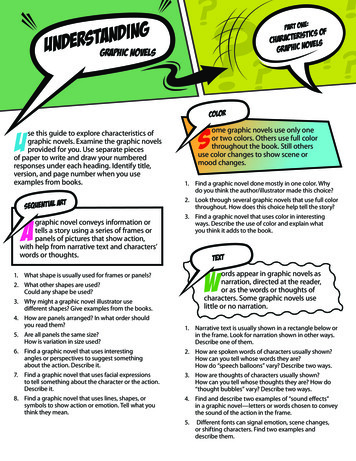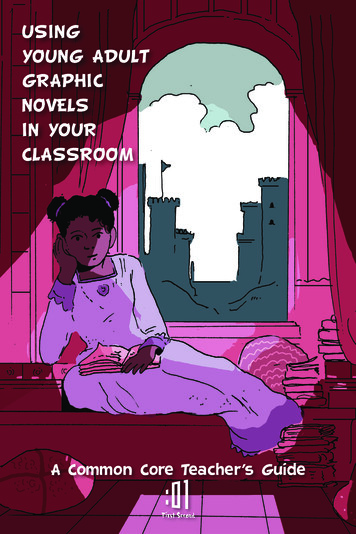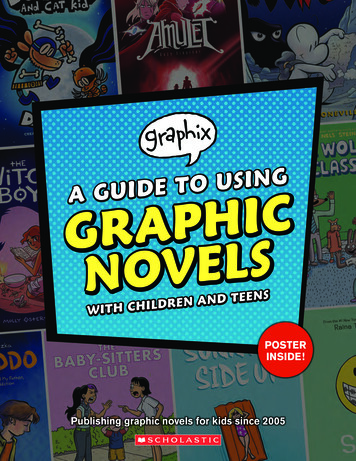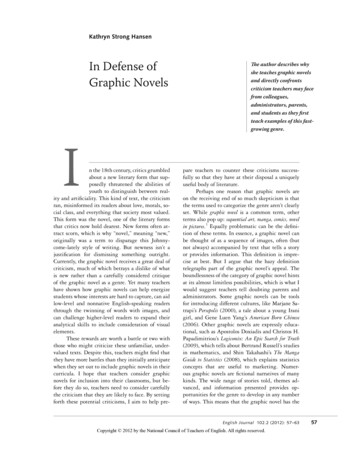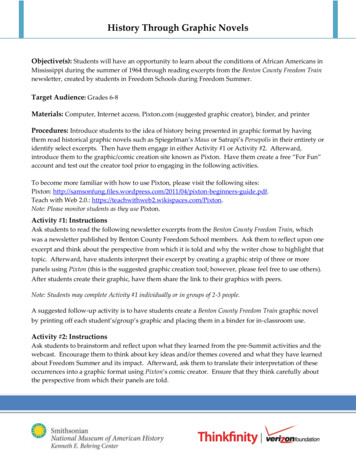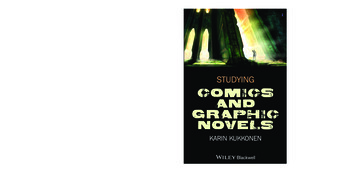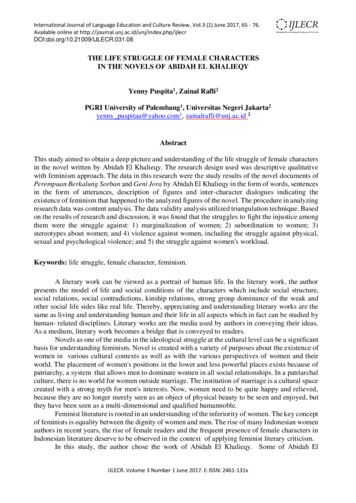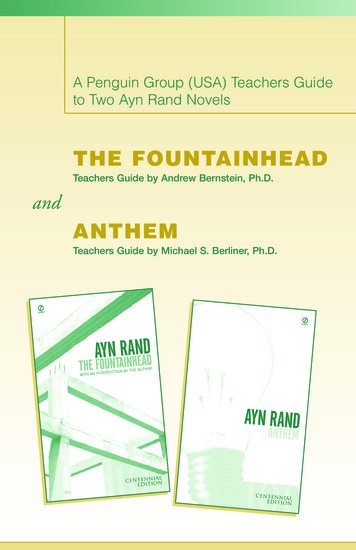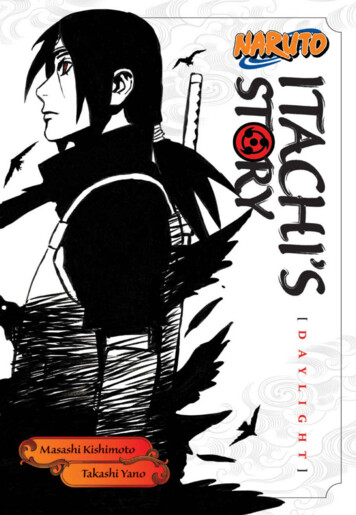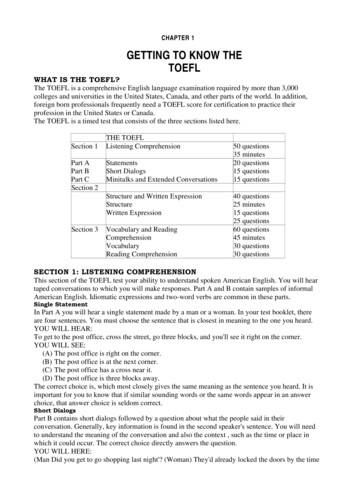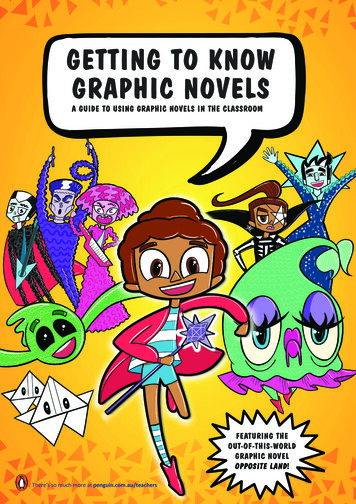
Transcription
GETTING TO KNOWGRAPHIC NOVELSA GUIDE TO USING GRAPHIC NOVELS IN THE CLASSROOMFEATURING THEOUT-OF-THIS-WORLDGRAPHIC NOVELOPPOSITE LAND!There’s so much more at penguin.com.au/teachers
RECOMMENDED FORMiddle–upper primary(ages 8–11; years 3 to 5)CONTENTS3.What is a graphic novel?3.What is the diffference between a graphic novel and a comic book?3.Why are graphic novels important for learning?5.How to read a graphic novel6.Graphic novel terms7.Classroom activities – graphic novels9.About Opposite Land9.About the author10.Visual literacy in Opposite Land11.Themes14.Classroom activities – Opposite Land16.Draw your own comic with Charlotte Rose Hamlyn17.Further reading from Penguin Random House AustraliaKEY CURRICULUM AREAS Learning areas: English General capabilities: Literacy, Critical and Creative Thinking, Visual Language Cross-curriculum priorities: N/AREASONS FOR STUDYING THIS BOOK Learning about visual literacy Learning about graphic novels Learning about imaginative thinking and creativityTHEMES Friendship Individuality Bullying Diversity Courage Imaginative thinkingPREPARED BYPenguin Random House AustraliaPUBLICATION DETAILSISBN: 9780143780816 (paperback); 9780143780809 (ebook)These notes may be reproduced free of charge for use and study within schools but they may not be reproduced (either inwhole or in part) and offered for commercial sale.Visit penguin.com.au/teachers to find out how our fantastic Penguin Random House Australia books can be used in the classroom, sign up to the teachers’ newsletter and follow us on @penguinteachers.Speech bubbles sourced from freepik.comStarburst on cover sheet sourced from clipartfest.comIllustrations by Charlotte Rose HamlynCopyright Penguin Random House Australia 2017There’s so much more at penguin.com.au/teachers
What is a graphic novel?A graphic novel uses the interplay of text and illustrations in a comic-strip format to tell a story.Instead of relying on just text to construct a narrative, it uses graphical elements such as panels,frames, speech/thought balloons, etc. in a sequential way to create and evoke a story in a reader’smind.What is the difference between a graphic novel and acomic book?A graphic novel is a longer, more complex piece of text thatusually covers the storyline in one book, whereas a comic book isa lot shorter and tells the story over many issues and/or volumes.DID YOU KNOW?The first graphic novel believed to havebeen published was an adaptation of aGerman stage play called Lenardo andBlantine in 1783. The ‘graphic novel’was illustrated by Joseph Franz vonGoez and contained 160 frames.Why are graphic novels important for learning?A graphic novel, much like any book, is an important tool forcognitive learning and is rich in visual literacy. Readers activelyparticipate in its construction by inferring what they see from the image and linking it to thecorresponding text to understand the narrative developing from panel to panel, or picture topicture.The order and organisation of the panels, images and text on the page determine the flow andmovement of the story by giving the reader cues as to what their eyes should follow next. Forinstance, the reader will first see the panel, then the text linked to the main image, and from thereget a sense of the scene as they continue to move on to the following panels. The setting andenvironment in a graphic novel is established through images, likewise with character expressions,which are all conveyed visually as opposed to word descriptions in traditional straight-text novels.In this way, the more ‘image-based’ aesthetic of the graphic novel can make it a less intimidatingread for beginner and ESL readers. Instead of having a wall of text, the story is broken up intoimages, with or without short pieces of text, which play a significant role in shaping the narrative.It allows readers to understand ‘words through pictures’.There’s so much more at penguin.com.au/teachers3
DID YOU KNOW?The term ‘graphicnovel’ gainedpopularity in thelate 1970s, andwas introducedby fan historianRichard Kyle.Graphic novels can be considered an important bridge forgreater reading development and exploration of ideas, becauseconfidence gained from this medium could propel the reluctantreader to seek out more textually challenging books. And becausegraphic novels cover a range of genres from fiction (e.g. superherostories and manga) to non-fiction, such as autobiographies,memoirs, true stories and information books (e.g. Maus,Persepolis, Smile, March, Papercutz’ Dinosaur series), the breadthof topics for study and immersion stretch far and beyond.The age of visual literacy, in which society is becoming more and more steeped in visual mediathrough the use of technological devices like mobile phones and tablets, shows us that readingbehaviour has developed to take into account the powerful role of images in meaning andinterpretation. Gina Gagliano of First Second, a Pan Macmillan imprint focusing solely on graphicnovels for children, comments that ‘Visual literacy is an essentialpart of today’s curriculum. Kids need to learn to interact with imagesDID YOU KNOW?because it’s a large part of how we communicate today.’ (http://The world’s largest comic bookcollection is housed in ews/libraries/Library of Congress tml)Washington DC in the US.The popularity of fusion or ‘hybrid’ text in series like Diary of aWimpy Kid and Tom Gates, which mixes text and illustrations to forma unified narrative, offer graphic novels a commercial platform fromwhich to grow.Online resources: Creating Multimodal Texts: https://creatingmultimodaltexts.com/comics/ Graphic Novels in the Classroom: http://courseweb.ischool.illinois.edu/ gray21/GraphicNovels/ The Truth About Graphic 32n2/fletcherspear.pdf Get Graphic (Graphical resources for teachers): http://www.getgraphic.org/teachers.php How to Teach Graphic /2015/nov/30/how-to-teach-graphic-novels A Teacher Roundtable: vels/4There’s so much more at penguin.com.au/teachers
HOW TO READ A GRAPHIC NOVELLayoutLeft to rightUp h bubbleThought bubble5There’s so much more at penguin.com.au/teachers
GRAPHIC NOVEL TERMSpanelthe box or segment that contains the image and textframethe border that surrounds and contains the panelgutterthe space that lies between panelsbleedwhen an image goes beyond the borders of the pagegraphic weightcaptionthe heaviness or intensity of a line or block of shading for visual focus. Thebolder the graphic weight, the greater the visual focus, making that elementmore salient in the scene.a box or section of text that gives details on the background and setting of thescene. It sits separately to speech and thought bubbles, often at the top or bottomof the panel.speech bubblethis contains the dialogue spoken by different characters within a scene. It’susually enclosed in a bubble or another shape; otherwise, can stand on itsown, close to the speaker.thought bubblesimilar to the speech bubble, this contains the internal dialogue of acharacter and is usually shaped like a cloud, coming from the character’sheadspecial effects soundslayoutwords that give a sense of sound on the page (e.g. BANG! THUMP!).To heighten their impact, the words are either bolded or have aspecial graphical treatment to make it stand out on the page.the configuration of all the elements on the page; the way in which the frame,panels, speech bubbles, etc. are arranged to tell the narrativeclose-upan angle that zooms into an image, like a character’s face, to allow for closer view.This technique is sometimes employed to convey a feeling of intimacy between thereader and character, such as when a character reveals their thoughts or revelations.6There’s so much more at penguin.com.au/teachers
CLASSROOM ACTIVITIES – GRAPHIC NOVELS1.Find one copy each of a picture book, novel and graphic novel. Flick through and study thepages. How is each medium different or similar to the other? Write your answers down onthe chart below.TEXT(e.g. How does thetext appear? Does itchange for differentparts of the story?)LAYOUTILLUSTRATIONS GRAPHICAL(e.g. Do the pagesELEMENTS(e.g. How are theelements on the page have anyarranged? Is it allillustrations or not?)text or are there someimages? How manypages are there?)(e.g. Are there anygraphical elements fortext breaks or �s so much more at penguin.com.au/teachers
2.Unlike the traditional novel, graphic novels rely on ‘visual’ sound effects, like BANG!STOMP!, which illustrate the word so that it can be graphically recognised. For example,BANG! can be drawn in big, bold letters that stand out prominently on the panel. Look atthe words below and see how you can illustrate these sound effects to suit the noises theycreate.SOUNDWORD AS GRAPHIC‘Shhhhh!’ she hissed tothe man as the movieplayed.KERBLAMMO!The factory explored intosmithereens.Bounce! Bounce! Bounce!went the ball.8There’s so much more at penguin.com.au/teachers
ABOUT OPPOSITE LANDWelcome to Opposite Land – where socks wear feet, broccoli ismeat, behind is ahead, and people poop from their head!After the worst day ever, Steve discovers a strange book writtenupside down and back to front. That night, when its wordsbecome mysteriously clear and Steve begins to read them, she’stransported to the topsy-turvy world in the book – OppositeLand. In this extraordinarily peculiar place, roads float in mid-air,people live in giant snail shells and monsters are made of pasta!But all that will change once Emperor Never gets his way anddestroys Opposite Land for good. When a flying cabbage calledSanjiv reveals that Steve is the only one who can defeat theemperor, it’s up to Steve to face her fears and save the world.Can Steve help restore Opposite Land to its former glory and find her way back home?ABOUT THE AUTHORCharlotte Rose Hamlyn is a Sydney-based storyteller and an awardwinning screenwriter for cartoons like Beat Bugs, Blinky Bill, Tashiand Guess How Much I Love You?. She’s also a television presenter forChannel 7’s art and craft show Get Arty, voices cartoon characters,including Marcia the Mouse in Blinky Bill: The Movie, and is a retiredprofessional fairy. Earlier in her career, Charlotte made short filmsabout spiders with human-phobias and worked for Academy Awardwinning director George Miller on Happy Feet 2. She grew up inAdelaide, Australia, but now lives in Sydney, where she spends hertime writing and drawing in a colourful house full of art, plants andlots of pencils. She likes sequins, and pineapple on pizza.9There’s so much more at penguin.com.au/teachers
VISUAL LITERACY IN OPPOSITE LANDIn Opposite Land, the author uses the graphic-novel medium to illustrate Steve’s adventure toa completely upside-down world. Each page contains a sequence of panels, which are framedor unframed, to show how the narrative develops and unfolds. The uniqueness of this world ischaracterised by the bizarre characters and environment, which are made up of various designs,patterns, lines and symbols. These patterns and lines also create a sense of movement, by guidingthe reader’s attention to the mood and action on the page. It gives them a reading path fromwhich they can navigate through the other visual elements of the scene towards the main focus.For instance, in Chapter 1, the bold lines and stripy background point towards Steve as she getstrapped in her school chair – indicating not only the movement of the chair as it snaps her in, butvisually conveying the unwanted attention she receives from her classmates sitting next to her.The author also employs visualisation by establishing a connection between the text and imageto make the meaning or sentiment stronger. We see this in the pasta monsters, where eachcharacter’s costume and features are made up of their namesake, like Macaroni Medusa, who hasmacaroni-shaped eyeballs and nose, and a macaroni-patterned dress. Further to this, symbols areused as a way to identify how a character is feeling (e.g. Steve surrounded by love hearts whenshe eats ice-cream, her favourite food) and what they’re doing (musical notes whenever the pastamonsters play their instruments).The use of frames, along with the variety of shapes, lines and patterns,play a big role in communicating emotion in a more abstract way. Atthe start of the story, when Steve gets angry at Mum and marches intoher bedroom (Chapter 1), the sequence is shattered into seven shardsof action, starting with Steve grabbing the book and ending with herslamming the door to her bedroom. The jagged framing of these minipanels resonate with Steve’s frustrations and visually pre-empt thesmashed window on the next panel.Another way to portray the action and energy of the scene is throughthe use of sound effects, where text is given a graphical treatment.Sound effects are visualised and are drawn according to the natureand behaviour of the word. An example is the drawn-out ‘Roooar’coming from The Never in Chapter 14. It emerges from the top of the10There’s so much more at penguin.com.au/teachers
panel and follows the shape of The Never, haunting Steve as she runs in fear.The size and appearance of the sound effect combined with the image createsa mood and atmosphere characteristic of the scene. Further to this, breakoutwords within the dialogue is bolded to help amplify the tone of speech, aswell as adds more emphasis. The author also uses rhyming verse to showcasethe whimsicality and playfulness of Opposite Land (‘Pigs can fly, and flies just fall; in fact, a fly can’tfly at all’), while also helping younger readers understand common sounds and common letters.One of the most powerful techniques the
A graphic novel, much like any book, is an important tool for cognitive learning and is rich in visual literacy. Readers actively participate in its construction by inferring what they see from the image and linking it to the corresponding text to understand the narrative developing from panel to panel, or picture to picture. The order and organisation of the panels, images and text on the .
